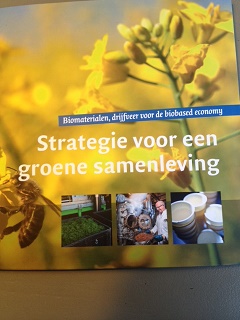The recent report ‘Strategy for a green society’ (in Dutch) of the Scientific and Technological Committee for the biobased economy (WTC) puts an emphasis on biobased materials. Biobased materials are the driving force for the biobased economy, according to the report’s subtitle. ‘The development of biobased materials fits excellently into both present technological capabilities, and consumer demand.’

A shift towards the regional level
In the past few years, remarkably many companies that develop biobased materials have received support from regional authorities. Partly, this is a result of the economic crisis: national governments cut down expenditure on R&D, regional authorities fill up the gap that opens up. And partly, this is the result of the excellent match that can be made in this area. ‘The Chemicals & Materials sector is one of the most important pillars of our wealth,’ the WTC writes with an eye on the Netherlands, ‘and materials are responsible for some 80% of the volume in that sector. Materials, ranging from simple polymer construction materials to high-quality coatings and medicines. Both in price and in volume, there is a wide spectrum in products on the market with a multitude of local or regional possible outlets. A positioning in the international arena is not required right away – but in most cases very well feasible after a successful start-up. In short, excellent starting positions for small en medium-size entrepreneurs who are strongly present in this sector.’
In other words: innovative SMEs in the materials sector can develop within the relative calm of regional markets and do not have to compete at world market prices right away. If they concentrate on biobased materials, they can acquire their feedstock regionally. Often, they may build upon knowledge and experience in traditional fibres like paper, cardboard and textiles, and in polymer producing and processing.

A new development model
The WTC outlines the possibility of a new development model, starting from regional strengths: ‘A strong development of biobased materials might subsequently be the stepping stone towards the development of high-value fine chemicals, additives, cosmetics (and) medicines…. Biobased materials then might become the driving force of economic development, a role that we first saw in bioenergy; therefore, they are the logical next step in the biobased economy, particularly in the Netherlands. On the firm basis of biobased materials we might further evolve towards higher quality products; and in this market, good regional sales are an excellent stepping stone towards world markets. The development of crops containing valuable components, in particular in horticulture, is an excellent addition to this. We see opportunities for a new national basic industry in biobased materials. Consequently, this should be at the heart of a policy intended to stimulate knowledge and innovation.’
For the future, WTC suggests a rather holistic approach of biomass: ‘We are in the process of developing much knowledge about structure and functioning of many materials in nature, and we develop ways and means to apply this knowledge in the development of new materials or improvement of existing ones…. In the long run, the goal of using biomass is that we will be able to make full use of its complexity. In that complexity, nature itself more or less developed the solution to many materials problems.’ If the polymer industry would first concentrate on biopolymers, that would be an excellent starting point for further development of an industry that makes full use of solutions already developed by nature. Says the WTC.
Strategie voor een groene samenleving (in Dutch) in pdf
Press release and downloadable version in Word
